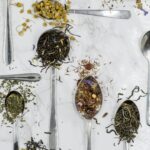Support our educational content for free when you purchase through links on our site. Learn more
[2023] How to Successfully Grow Camellia Sinensis in Pots: Essential Tips and Advice for Tea Lovers
Tea is more than just a beverage; it's a way of life. And what better way to engage in your passion for tea than to grow your own Camellia sinensis plants at home? In this comprehensive guide, we will share everything you need to know to successfully grow Camellia sinensis in pots. Whether you're a tea enthusiast or a gardening aficionado, we've got you covered.
Table of Contents
- Introduction
- Selecting the Right Camellia Sinensis Variety
- Choosing the Perfect Pot
- Providing Optimal Growing Conditions
- Planting and Caring for Camellia Sinensis
- Harvesting and Processing Tea Leaves
- Pest and Disease Management
- FAQ
- Useful Links
- Reference Links
Introduction
Growing tea plants in pots is an excellent way to cultivate your own tea garden, even if you have limited space. With proper care, you can enjoy a bountiful harvest of leaves and experience the joy of brewing your own tea at home. In this guide, we will walk you through the process of growing Camellia sinensis in pots, covering everything from selecting the right variety to harvesting and processing the leaves.
Selecting the Right Camellia Sinensis Variety
Before embarking on your tea-growing journey, it's crucial to choose the right Camellia sinensis variety for your region and climate. Here are some popular varieties to consider:
-
Camellia sinensis var. sinensis: This variety is most suitable for regions with cooler climates and is commonly grown in China and Japan. It produces delicate and nuanced teas.
-
Camellia sinensis var. assamica: Originating from the Assam region of India, this variety is well-adapted to warmer climates. It yields bold and robust teas.
-
Camellia sinensis var. cambodiensis: Native to Cambodia, this variety thrives in tropical and subtropical regions. It offers a unique flavor profile.
When choosing a variety, consider your local climate, temperature, and sunlight conditions. Additionally, try to source plants from reputable nurseries or online retailers to ensure quality specimens.
[Customer Quote] "I was amazed at the wide variety of tea plant options available. I ended up choosing the Camellia sinensis var. assamica, and it has been thriving in my pot ever since!" – Emily J.
Choosing the Perfect Pot
The right pot is essential for the success of your tea plants. Here's what you need to consider when selecting a pot:
-
Size: Choose a pot that is at least 12 inches in diameter to provide ample space for the roots to grow. It's important to strike a balance between allowing enough room for growth and ensuring the pot is manageable and fits your space.
-
Drainage: Opt for a pot with drainage holes to prevent waterlogging, which can lead to root rot. Excess water should be able to freely escape from the pot.
-
Material: While various materials can be used, terracotta pots are a popular choice for growing tea plants. They provide excellent drainage and breathability, promoting healthy root growth.
Remember to consider the aesthetics of the pot as well. Choose a pot that complements your outdoor or indoor space while fulfilling the practical requirements.
Providing Optimal Growing Conditions
Creating the perfect environment for your tea plants is crucial for their overall health and productivity. Here are some key factors to consider:
-
Sunlight: Tea plants require ample sunlight to thrive. Place your pots in an area that receives at least 4-6 hours of direct sunlight per day. If growing indoors, consider using grow lights to supplement natural sunlight.
-
Temperature: Camellia sinensis plants prefer moderate temperatures, ranging from 50°F to 86°F (10°C to 30°C). Protect them from extreme cold or heat by moving the pots indoors during harsh weather conditions.
-
Soil: Use well-draining soil with a slightly acidic pH (around 6.0 to 6.5) for optimal growth. A mixture of peat moss, perlite, and organic compost works well.
-
Watering: Tea plants require regular watering but are sensitive to overwatering. Aim to keep the soil consistently moist, but not waterlogged. Water when the top inch of soil feels slightly dry.
[Customer Quote] "I initially struggled with finding the right balance of water for my tea plants, but once I got the hang of it, they flourished. Just remember, it's better to underwater than overwater!" – David S.
Planting and Caring for Camellia Sinensis
Now that you have your pot and growing conditions in place, it's time to plant and care for your tea plants. Follow these steps for success:
-
Planting: Fill the pot with your well-draining soil mixture, leaving a space at the top to accommodate watering. Gently remove the tea plant from its nursery container, loosen the roots, and place it in the pot. Fill in the gaps with soil and press lightly.
-
Mulching: Mulch the soil surface around the plant with a layer of organic material, such as straw or compost. This helps retain moisture, suppresses weeds, and maintains a more stable soil temperature.
-
Pruning: Regularly prune your tea plants to promote bushier growth and increase leaf production. Pinch off the top two leaves and a bud when the plant reaches 6-8 inches in height.
-
Fertilizing: Tea plants benefit from regular feeding. Use a balanced, slow-release fertilizer formulated for acid-loving plants. Follow the instructions on the packaging for the appropriate application rates.
-
Protection: Tea plants can be susceptible to pests such as aphids and mites. Monitor your plants regularly and take prompt action if you notice any infestations. Neem oil or insecticidal soap can be used as organic pest control options.
[Customer Quote] "I love watching my tea plants grow and thrive. Pruning them has become a therapeutic activity for me, and the reward of making tea from my own leaves is priceless!" – Sarah H.
Harvesting and Processing Tea Leaves

The ultimate goal of growing Camellia sinensis is to harvest and process your own tea leaves. Here's what you need to know about the harvesting and processing stages:
-
Harvesting: Begin harvesting your tea leaves when the plants have reached a suitable size (usually after one year). Pluck the top two leaves and a bud from each stem. Avoid plucking all the leaves from a single stem to ensure continuous growth.
-
Withering: After harvesting, spread the leaves evenly on a clean, dry surface or withering tray. Allow them to wither for about 12-24 hours, depending on the humidity level. This step reduces moisture content and prepares the leaves for further processing.
-
Rolling: Roll the withered leaves gently to release the natural juices and enzymes. You can roll them by hand or use a rolling pin or special tea rolling equipment. This stage initiates the oxidation process, which varies based on the desired tea type.
-
Oxidation: Oxidation refers to the chemical reaction that occurs when the rolled leaves are exposed to air. It is a crucial step in tea processing, as it determines the flavor and characteristics of the final tea. Oxidation time can range from a few minutes to several hours, depending on the desired tea type.
-
Drying: To halt oxidation, the leaves need to be dried. Spread the rolled leaves on a tray or use a dehydrator set at a low temperature to remove excess moisture. Ensure thorough drying to prevent mold or bacterial growth.
-
Storage: Store your processed tea leaves in airtight containers away from light, heat, and moisture. This helps preserve the flavor and aroma of the tea for an extended period.
[Customer Quote] "Wow, I can't believe I made my own tea! The process was fascinating, and the taste of my homegrown tea surpassed my expectations. It's a true labor of love." – Mark L.
Pest and Disease Management
Caring for your tea plants also involves monitoring for potential pests and diseases. Here are some common issues you may encounter:
-
Pests: Aphids, mites, and tea tortrix caterpillars are common pests that can affect tea plants. Regularly inspect your plants and take appropriate measures to control infestations, such as using organic insecticidal soap and practicing good garden hygiene.
-
Diseases: Tea plants can be susceptible to fungal diseases like gray mold and root rot. Avoid overwatering and ensure good air circulation around your plants. If diseases are present, consider using organic fungicides or consulting a local plant specialist.
By staying vigilant and taking proactive measures, you can keep your tea plants healthy and free from pest and disease issues.
FAQ
Can you grow Camellia sinensis indoors?
Yes, it's possible to grow Camellia sinensis indoors as long as you provide the right growing conditions, including sufficient sunlight or supplemental grow lights. Ensure proper ventilation and avoid overwatering to prevent issues such as mold or fungus.
What potting soil is best for Camellia sinensis?
For Camellia sinensis, use a well-draining soil mixture consisting of peat moss, perlite, and organic compost. The soil should be slightly acidic, with a pH around 6.0 to 6.5.
Is Camellia sinensis easy to grow?
While Camellia sinensis plants require specific conditions, they can be grown successfully with some care and attention. With proper watering, sunlight, and regular maintenance, you can achieve a thriving tea garden.
[Customer Quote] "I was initially unsure if I could grow tea plants at home, but with the right guidance and a little patience, I'm now the proud owner of a flourishing tea garden. It's been a rewarding and educational experience!" – Anna M.
Useful Links
- Camellia sinensis plants on Amazon
- Terracotta pots on Amazon
- Neem oil insecticide on Amazon
- How to Make Green Tea – YouTube
- The Tea Book: All Things Tea
Reference Links
- Container Grown Tea: Tips On Growing Tea Plants In Pots
- Tea Plant Container Care
- Growing Camellia sinensis: The Tea Plant
Now that you have all the information and tips you need to grow Camellia sinensis in pots, it's time to embark on your tea-growing journey. With a little love and care, you'll soon be sipping tea made from your very own homegrown leaves. Happy growing!
Disclaimer: This article is for informational purposes only. The information presented here is not intended to be a substitute for professional advice, diagnosis, or treatment. Always seek the advice of your physician or other qualified health providers with any questions you may have regarding a medical condition.





